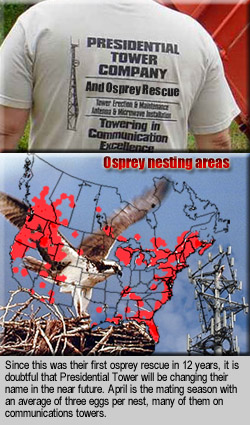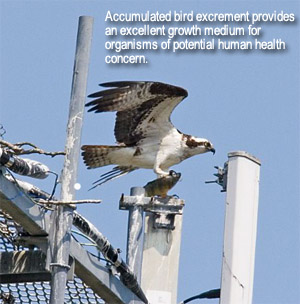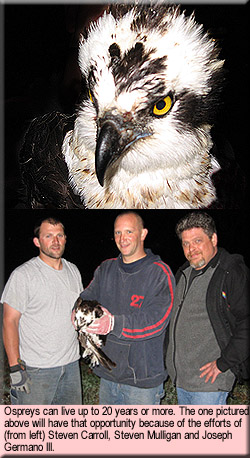|
Cell tower's resident raptor freed in early  morning rescue mission morning rescue mission
May 2, 2008 - Emergency nighttime work for tower erectors oftentimes involves a host of unexpected maintenance issues, but two New Jersey tower technicians were tasked with an unusual project when they arrived at a cell site last Friday in Lower Mount Bethel Township, PA.
Instead of a job site meeting with the tower's owner, Crown Castle International, Steven Mulligan and Steven Carroll from Presidential Tower Co., located in West Berlin, NJ, were given instructions by Brad Kreider, a Pennsylvania Game Commission wildlife conservation officer.
Their mission, far removed from maintenance, Kreider explained, was to quickly learn proper raptor rescue techniques and free an osprey that had been stuck upside down on the monopole at the 100-foot level for at least eight hours, before it became a retrieval effort.
Talon was caught behind antenna pipe
Bird watcher Lillian Shupe and her husband, Jim, saw the bird dangling from the tower Thursday evening.
"I have never seen one get caught like that," Shupe said. "It was hanging upside down flapping its wings. The female was flying around him and into him trying to help him get free."
After more than a dozen phone calls, Shupe finally got in touch with the Pennsylvania Raptor and Wildlife Association, who contacted Kreider. The conservation officer called the tower's owner, Crown Castle International, whose representative immediately called Presidential Tower's co-owner Joseph Germano III for assistance.
Shupe and her husband were impressed that Crown Castle, sent Germano and his tower hands out at 2:00 a.m.
Kreider instructed Mulligan and Carroll to put the bird into a canvas bag once they got it out of the tower so it could be examined before being released back into the wild.
Germano said that one of the osprey's talons was caught behind an antenna pipe and u-bolt, and it was unable to right itself from the monopole's pipe mount that provided a perfect perch for viewing an adjoining lake.
"You get a call like that and you have to go. It's worth it," Germano said. "We see their nests all the time. But to actually get to touch one, it's amazing. It's a beautiful bird," said Germano who noted that the Ospreys might have been using the rather large nest that was on top of the monopole.
Illuminated by two spotlights, the tower techs began their ascent to free the osprey. Wearing harnesses and gloves and armed with rope, and a canvas bag, the men unhooked the osprey's talon that was wedged behind the antenna pipe, placed the bird into the bag and carefully lowered it down to Kreider. The rescue took about 90 minutes. 
Kreider examined the osprey and found no major health problems, then transported the bird to the Pennsylvania Raptor and Wildlife Association in Upper Mount Bethel Township.
Hope Anwyll and Tom Nelson, co-directors of the association, released the osprey about 9 a.m, noting that the raptor did not endure any broken legs or suspension trauma, but had only suffered abrasions on his legs as it rubbed against the antenna mounting hardware to get lose.
Ospreys do vigorously defend their nest sites from intruders. This is most likely because nests are used by the same pair for many years, and represent a significant investment of time and energy by that pair.
Tower technicians have to keep an eye upon swooping irate ospreys that view them as the only predators that can climb to their nest in its normally safe elevated environment, although raccoons on occasion have scaled considerable heights.
In addition, they must use caution when working on sites that do not have any ongoing osprey activity due to the hawks' droppings. Accumulated bird excrement provides an excellent growth medium for organisms of potential human health concern.
Adult ospreys are approximately 24-inches in length and have wing spans between five and six feet. They are the only bird of prey that feeds exclusively on fish.
These large birds nest along streams, reservoirs, and lakes and can provide an un-welcomed coating of droppings and fish parts on transmission lines, connectors and antennas over a period of time.
Ospreys are not listed under the Endangered Species Act, although they were listed after the Act's passage in 1973. Experts are encouraged by the ospreys' population growth, but feel the species is still in need of continued assistance
for complete recovery.
These raptors are still listed as threatened, endangered or a species of special concern in several U.S. states. Ospreys are also protected under the U.S. Migratory Bird Act.
Due to its large amount of water bodies, Florida has one of the largest osprey populations in America. Their nests can oftentimes render a cell site inoperable when they are built over transmission lines and other equipment that needs to be serviced.
If the nest is inactive and contains no eggs or flightless young, a permit can be obtained to remove the nest, but a replacement nesting platform requires that the tower owner must provide a replacement nesting platform/structure of comparable or better quality.
|